Transportation bill offers key pieces for Oregon’s future + more work to be done
 The Oregon Legislature’s Joint Committee on Transportation Preservation and Modernization just released the long-anticipated House Bill 2017 – a 298-page plan for funding transportation improvements across our state over the next ten years. Hearings are happening now, take action today!
The Oregon Legislature’s Joint Committee on Transportation Preservation and Modernization just released the long-anticipated House Bill 2017 – a 298-page plan for funding transportation improvements across our state over the next ten years. Hearings are happening now, take action today!
“We are pleased to see a plan that gets Oregon moving towards reducing pollution, increasing safety, and making transportation more affordable for working families. At the same time, there’s more work to do to ensure the package reduces transportation-related pollution across the state,” said Chris Hagerbaumer, Deputy Director, Oregon Environmental Council.
Our policy experts are evaluating details of the plan to ensure that it stays true to Oregonians’ long-standing values of investing in a modern transportation system that serves the next generation, providing more options for everyone—including well-maintained roads and bridges, convenient public transportation, safe places to walk and bike, and clean vehicles.
Here are our initial takeaways:
A Major Investment in Public Transit
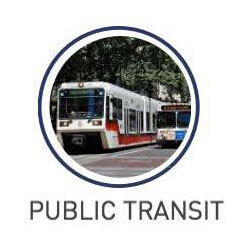 A statewide employee payroll tax would fund rural and urban transit all around the state, providing Oregonians access to jobs and other daily needs. Importantly, transit agencies will be required to demonstrate how their increased transit service will meet the needs of lower-income Oregonians. Public transit is a lynchpin for the package, and we are asking the legislature to also fund a companion bill focused on student transportation, HB 2693, which includes grants to support youth transit passes.
A statewide employee payroll tax would fund rural and urban transit all around the state, providing Oregonians access to jobs and other daily needs. Importantly, transit agencies will be required to demonstrate how their increased transit service will meet the needs of lower-income Oregonians. Public transit is a lynchpin for the package, and we are asking the legislature to also fund a companion bill focused on student transportation, HB 2693, which includes grants to support youth transit passes.
Safe Routes to School and Bicycle/Pedestrian Infrastructure
 The package will begin to help children safely walk and bike to their neighborhood school, but the package should do more. We’re advocating that the bill be at least as strong as the components outlined in House Bill 3230. The package makes a small nod to other bicycle/pedestrian needs, including some inter-jurisdictional road transfers that will enable localized solutions to serious safety problems, but the investments are small in comparison to the need, and the allotment of 7% of ConnectOregon dollars and transfer of $4 million from the State Parks & Recreation Department for bike trails is not new money. The new source of funds is an excise tax on bicycles,which is frustrating given that bicyclists do pay for local infrastructure through property taxes and benefit the community via cleaner air, lower societal health burden, less congestion, and more.
The package will begin to help children safely walk and bike to their neighborhood school, but the package should do more. We’re advocating that the bill be at least as strong as the components outlined in House Bill 3230. The package makes a small nod to other bicycle/pedestrian needs, including some inter-jurisdictional road transfers that will enable localized solutions to serious safety problems, but the investments are small in comparison to the need, and the allotment of 7% of ConnectOregon dollars and transfer of $4 million from the State Parks & Recreation Department for bike trails is not new money. The new source of funds is an excise tax on bicycles,which is frustrating given that bicyclists do pay for local infrastructure through property taxes and benefit the community via cleaner air, lower societal health burden, less congestion, and more.
Roads and Multimodal Freight Improvements
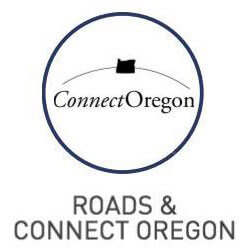 The package will go a long way to fixing state, county and city roads, as well as funding important freight infrastructure through ConnectOregon. We appreciate that stakeholders all over the state called for removing bottlenecks in the Portland region. While some fixes are warranted, research clearly shows that widening roads only leads to more traffic, more pollution and eventually back to gridlock, so we’re very pleased to see a move toward using existing road space more efficiently through peak period pricing and other smart technologies.
The package will go a long way to fixing state, county and city roads, as well as funding important freight infrastructure through ConnectOregon. We appreciate that stakeholders all over the state called for removing bottlenecks in the Portland region. While some fixes are warranted, research clearly shows that widening roads only leads to more traffic, more pollution and eventually back to gridlock, so we’re very pleased to see a move toward using existing road space more efficiently through peak period pricing and other smart technologies.
That said, the bill appears to list a number of pet roadway projects. It’s important to analyze these to make sure they are the top priorities in adopted Regional Transportation Plans and local Transportation System Plans.
We support the new privilege tax on the retail sale of motor vehicles–it has a perfect nexus to transportation. However, by restricting it to being spent on roads and freight alone, the state misses an opportunity to reduce congestion through multimodal investments and to invest in clean vehicles.
Electric Vehicles
 The package won’t move the needle when it comes to accelerating the purchase of electric vehicles (EVs). We encourage the legislature to fund the EV incentives outlined HB 2704. We are also disappointed that the package creates a tiered registration fee that charges more for efficient vehicles and increases that charge over time. Given that only 2% of cars in Oregon currently get better than 40mpg, it’s premature. In fact, the way it’s structured, an EV could easily end up paying more for the roads than a “gas-guzzler.” That’s because registration and title fees are fixed fees that don’t reflect actual road use..
The package won’t move the needle when it comes to accelerating the purchase of electric vehicles (EVs). We encourage the legislature to fund the EV incentives outlined HB 2704. We are also disappointed that the package creates a tiered registration fee that charges more for efficient vehicles and increases that charge over time. Given that only 2% of cars in Oregon currently get better than 40mpg, it’s premature. In fact, the way it’s structured, an EV could easily end up paying more for the roads than a “gas-guzzler.” That’s because registration and title fees are fixed fees that don’t reflect actual road use..
In addition, we’re concerned to see the existing Public Purpose Charge, which currently funds renewable and electricity projects, being diverted to fund recharging infrastructure. Not only is it the wrong source of funds, but the higher priority for EVs is purchase incentives.
Accountability
 We applaud legislators for including a number of provisions that will increase accountability and provide Oregonians more transparent information about their tax dollars are being spent to improve the way people and goods get around.
We applaud legislators for including a number of provisions that will increase accountability and provide Oregonians more transparent information about their tax dollars are being spent to improve the way people and goods get around.
Public hearings on HB 2017 are expected to occur next Tuesday, June 6 and Wednesday, June 7. Written testimony can be submitted at any time to this email address.
We encourage all Oregonians to participate in this process and advocate for a clean and modern transportation solution this legislative session. Stay in the loop: join Oregon Environmental Council’s Grassroots Action and Information Network.
Oregon Environmental Council is a member of Transportation for Oregon’s Future. For a full list of coalition priorities and partners visit: oeconline.org/transport4OR #transport4OR

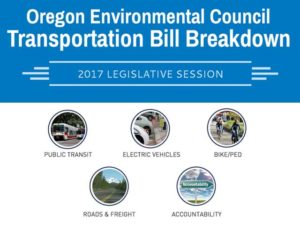





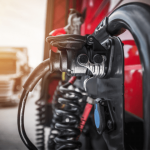

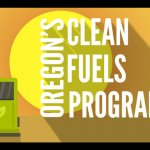


ALLAN RUDWICK
June 1, 2017 (10:09 pm)
regarding EVs — we should be encouraging EV miles, not EV ownership. Specifically we should encourage reducing miles driven by high-polluting vehicles.
Amy Lewin
June 1, 2017 (10:35 pm)
Thanks for your note Allan! The team at Oregon Environmental Council tackles transportation from all angles: helping people drive less and pushing for the cleanest vehicles and fuels. For the foreseeable future, all of these solutions are necessary to meet our greenhouse gas reduction goals, though we appreciate your comment.
Zef Wagner
June 3, 2017 (12:31 am)
I was surprised by the statement that purchase incentives are more important than recharging infrastructure. I was under the impression that the biggest barrier to purchasing EVs was range anxiety, which makes sense because there really are very few charging stations, especially for longer trips out of town. Ideally all gas stations would have quick charging stations, something I noticed on a recent trip to the UK and Iceland was very common in those countries. There are also need to be charging stations in the street in residential areas to address people who don’t have garages and typically park in the street.
admin
June 5, 2017 (6:36 pm)
Oregon actually has a lot of publicly available EV charging stations. It’s not that we don’t need more, but that the most effective way to advance electric vehicles (once a decent number of charging stations are out there) is “cash on the hood.” Multiple studies – and real-world experience – shows that lowering the upfront purchase cost of these cars is the best way to increase sales.[1] There are also strong counter-examples: for example, the Atlanta area emerged as a top electric vehicle market thanks to a $5,000 state incentive. When that incentive ended, sales dropped over 80%.[2] While Oregon has been a leader in many ways, electric vehicle sales are still lower here than in neighboring California and Washington State, which both provide incentives for vehicle purchase.
[1] https://www.nytimes.com/2015/10/17/business/international/norway-is-global-model-for-encouraging-sales-of-electric-cars.html?_r=0
[2] http://www.utilitydive.com/news/georgia-electric-vehicle-sales-shrink-80-in-wake-of-tax-credit-repeal/434092/
Oregon's Transportation Bill | Oregon Environmental Council
January 17, 2019 (8:39 pm)
[…] Transportation bill offers key pieces for Oregon’s future + more work to be done […]